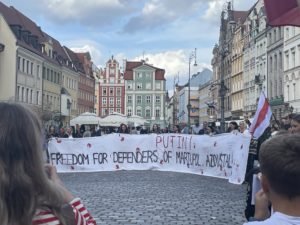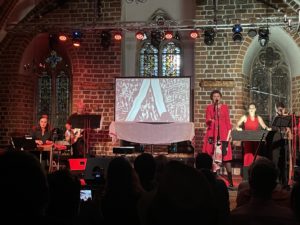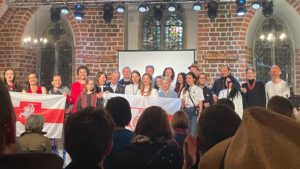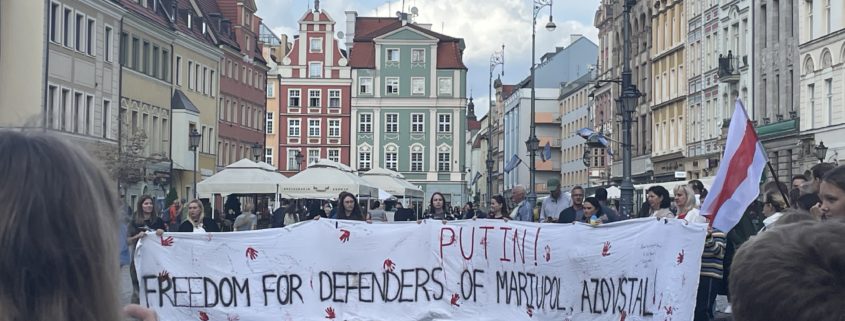Cultures in Exile: The Impact of Ukrainian and Belarusian Identities on the Souls of Polish Cities
By Anna Meehan
You can tell a lot about a city from the sights and sounds of their centers. Home to restaurants, cafes, statues and gift shops, Wroclaw’s Old Town serves as the heart of this exuberant Polish city. While the visual nature of Wroclaw harkens back to its medieval past and Polish present, the longer one spends wandering the city’s cobblestone streets the more evidence of a complex history emerges. As the proverb goes, “no man ever steps in the same river twice”. I’ve found this statement to be equally applicable to cities, and have thus concluded that one cannot visit the same city twice either. Despite Wroclaw’s distinct Polish appearance, it is a city in a constant state of transition.

Flags of the Belarusian People’s Republic fly in Wroclaw’s market square, alongside several Ukrainian flags, standing in solidarity. Photo by Anna Meehan.
There is something about each city which is distinct. Of course, Old Towns across Europe have their similarities, yet their individual character shifts from Wrocław to Gdańsk, and from Warsaw to Kraków. This character, hidden from plain view, may be considered the city’s “soul”, which is formulated by the cultures, languages and experiences of the people who occupy it. As I have travelled across Central Europe in recent months, I have observed these transitions in character, and find that understanding the soul of each city—considering its unique history, populations, and transitions—has provided a deeper understanding and appreciation for spaces once foreign to me. What makes a city’s soul abundantly clear are extended periods of observations through people watching.

Signs displayed at the protest in Polish, Belarusian, and English, spreading the message “Long Live Belarus” to as many people as possible. Photo by Anna Meehan.
One of my favorite pastimes when exploring a new city is to spend a quiet morning at an outdoor cafe. With my warm latte in hand, and a chocolate croissant at my side, I gaze out into the town square, observing the interactions between people and the spaces around them. Most people bustle past one another, grasping their coats against the crisp morning breeze. Tourists gaze upon the magnificent buildings towering over them. And during one autumn week, I saw two distinct flags in union with Poland’s.
The first flag I noticed belonged to the unofficial People’s Republic of Belarus. Somewhat similar to the Polish flag, this partisan banner features the pagonya in the center (a crest dating back to the medieval era, which is now a symbol of democratic Belarus), as well as a red stripe across a white background. While I was enjoying my coffee on a Sunday morning, I observed a gathering of Belarusians in the city square of Wroclaw, proudly waving their banners and singing national songs. Out of equal parts shock and curiosity, I left my table to join the crowd.

Women stand in unity with Belarusians, protesting Putin’s invasion of Ukraine. Photo by Anna Meehan.
Banners printed in Belarusian, Polish, and English read “Long Live Belarus”, the slogan of protesters opposing Lukashenko’s regime. Accompanying the demonstration was a crew of women holding a banner reading “PUTIN! FREEDOM FOR DEFENDERS OF MARIUPOL AZOVSTAL!”, wrapped in blue and yellow, the flag of Ukraine. Belarusians and Ukrainians, unified together, were protesting Vladimir Putin, Aleksander Lukashenko, and the injustices that those authoritarian dictators have afflicted.
Belarusian political dissidents, persecuted for protesting Lukashenko’s dictatorship, have sought refuge in Poland since repressions escalated following the falsification of their 2020 elections. After joining the demonstration in Wroclaw, chanting alongside men, women and children, I learned it served as the kick-off event to the Belarusian Culture in Exile Festival of Wroclaw. Speaking with an organizer of the event, he described the goal of the festival as offering a space for Belarusians to celebrate their culture, having been stripped of the right to do so under Putin-backed russification of their state. That evening, I attended a play entitled AUGUST, which depicted the lives of a family torn apart by certain members’ arrests, a result of their political resistance. I was fortunate to speak with one such dissident after the production, who articulated her own experience in a state prison.

Kaciaryna Vadanosava sings passionately while sand artist Alexandra Konofalksaya animates a protest scene of Belarusian people, referencing the 2020 protests regarding Lukashenko’s falsified election. Photo by Anna Meehan.
While she did not share the details of her of her imprisonment, other accounts of the protests reference inhumanely packed prison cells, torture, and rape of detainees. In the final scene of AUGUST, the number 1148 was illuminated on the stage, representing the number of days remaining protesters have spent in jail. This heart-wrenching display of art was met with tears, as Belarusian refugees recalled their own experiences, thankful to be given a voice in their refuge. A week later, I attended a concert entitled “KRAJ”, featuring vocalist Kaciaryna Vadanosava and artist Alexandra Konofalskaya, who shared their talents in support of Belarus. Their concert, which closed the festival was another overwhelmingly emotional and empowering experience. While no translation of the lyrics and commentaries were available, Vadanosava’s expressiveness and Konofalskaya’s animations brought their artistry to life, transcending the barriers of language. The message of their aspirations for freedom and an independent Belarus was clearly understandable to the Poles and other non-Belarusian speakers in the audience.

Members of the Belarusian Culture in Exile Festival stand together with the people’s flag at the festival’s final event. Photo by Anna Meehan.
In a 1966 article “The Past Submerged”, journalist Henry Kamm noted how since the end of WWII, Wroclaw, had been transformed into a undeniably Polish city despite having been “vigorously German” just twenty years prior. Kamm wrote: “There are those who say that cities have souls that transcends that of its people […] Perhaps, but they won’t be able to prove that here.” Today, Wrocław is once again being transformed. The presence of Ukrainians and Belarusians has added a new dimension to Wroclaw’s soul, a continuation of its history marked by dynamic change. Now and then, newly situated identities are obvious, as in the case of the Belarusian oppositionists demonstration, or in the youth who fundraise with Ukrainian flags wrapped around their shoulders. In my travels, I have observed similar patterns in other Polish cities. Krakow, now home to approximately 50,000 refugees (The First News), displayed a similar expression of Ukrainian identity. In the city’s Old Town, I caught wind of a violinist sawing out Hej, Sokoly!, a folk song shared by Poles and Ukrainians alike. The next night, a woman in a flowing gown offered a grandiose rendition of the National Anthem of Ukraine, her nation’s flag behind her as eager pedestrians joined in song. These instances shocked me, given the historic violence East-Galician Poles experienced during the Wołyń massacre starting at the end of the Second World War. A radical ethnic cleansing of Poles by the Ukrainian Insurgent Army claimed the lives of ~100,000 Polish citizens living in Nazi-occupied Ukraine (Polonia, Justice for Polish Victims), I assumed the soul of Krakow’s city would be haunted by this traumatic past, and thus resistant to Ukrainian identity. Instead, I witnessed solidarity. Had I visited Krakow before the invasion of Ukraine— a moment where fear of Russian aggression seemed to unify Poles and Ukrainians— would Krakow have been so enthusiastic to welcome Ukranians? Or, as in the case of Wroclaw, has history once again reconfigured the city’s soul?

“Polish and Ukrainian flags are often found flying together on the streets of Wroclaw. Photo by Anna Meehan.
Ukrainians and Belarusians, standing in unity, celebrate their cultures proudly on the streets of Poland’s cities despite living in exile. In each city, the Polish community seems to be tolerant, if not actively supportive, of these proud displays. Yet, I wonder, will the city’s soul always remain as tolerant? Prior to recent parliamentary elections, Prime Minister Mateusz Morawiecki announced that Poland would no longer send weapons to Ukraine (Stewart), a sign of returning tensions in Polish-Ukrainian relations. Furthermore, 2023 marks the 80th anniversary of the initiation of the Wołyń Massacre. While the alluded threats made by Putin and Lukashenko against Poland’s sovereignty, as well as the unjustifiable violence perpetrated against Ukrainians in Russia’s full-scale invasion have certainly contributed to Poland’s political stance thus far, one begs the question, what will happen to the relationships between ordinary Poles and Ukrainians once the shock of Russian aggression begins to dwindle? Will populist nationalism push back against these new identities’ visible impacts on the souls of Polish cities? Or will the daily contact of refugees and nationals instead acclimate cities’ souls, creating a new era of permanent diversity? Unfortunately, only time can tell. For now, Belarusians and Ukrainians proudly unite in Poland’s city centers, and Poles stand beside them, choosing solidarity in the face of adversity.
Works Cited
- Kamm, Henry. “The Past Submerged.” The New York Times, 19 Feb. 1966.
- “Krakow Still Home to 50,000 Ukrainian Refugees.” The First News, 3 June 2022, https://www.thefirstnews.com/article/krakow-still-home-to-50000-ukrainian-refugees-30807#:~:text=A%20hundred%20days%20since%20Russia%20invaded%20Ukraine%2C%20Krakow,Polish%20education%20and%20healthcare%20system%2C%20among%20other%20benefits.
- Polonia. “The Wolyn Massacre. 77 Years Ago, Around 100,000 Poles Were Slaughtered with Utmost Cruelty by Ukrainian Nationalists.” Justice For Polish Victims Of The Second World War, 2 Dec. 2020, justiceforpolishvictims.org/polish-experience/the-wolyn-massacre-77-years-ago-around-100000-poles-were-slaughtered-with-utmost-cruelty-by-ukrainian-nationalists/#:~:text=The%20killings%20were%20initiated%20and%20directed%20by%20a,purge%20all%20non-Ukrainians%20from%20a%20future%20Ukrainian%20state.
- Stewart, Briar. “Poland Says It Will Stop Future Weapon Transfers to Ukraine.” CBC News, CBC/Radio Canada, 22 Sept. 2023, www.cbc.ca/news/world/poland-ukraine-weapons-1.6973725.



